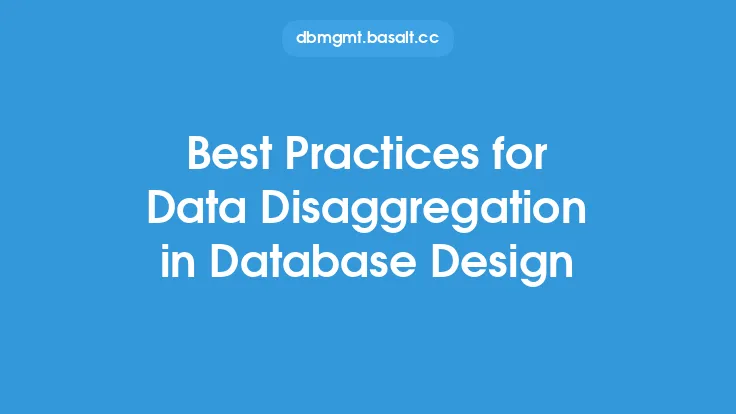Data transformation is a critical process in database management that involves converting data from one format to another to make it more suitable for analysis, reporting, or other uses. This process is essential in ensuring that data is consistent, accurate, and reliable, which is crucial for making informed business decisions. In this article, we will discuss the best practices for data transformation in database management, highlighting the key considerations, techniques, and tools that can help organizations achieve high-quality data transformation.
Introduction to Data Transformation
Data transformation involves a series of steps that include data extraction, data cleaning, data conversion, and data loading. The goal of data transformation is to take raw data from various sources, transform it into a standardized format, and load it into a target system, such as a data warehouse or a database. This process requires careful planning, execution, and monitoring to ensure that the transformed data is accurate, complete, and consistent.
Data Quality Considerations
Data quality is a critical aspect of data transformation. Poor data quality can lead to inaccurate analysis, incorrect decisions, and a loss of trust in the data. To ensure high-quality data transformation, organizations should consider the following data quality factors:
- Accuracy: Data should be accurate and free from errors.
- Completeness: Data should be complete and not missing any critical information.
- Consistency: Data should be consistent in format and structure.
- Validity: Data should be valid and conform to the expected format and range.
- Uniqueness: Data should be unique and not duplicated.
Data Transformation Techniques
There are several data transformation techniques that organizations can use to transform their data. These techniques include:
- Data aggregation: Combining data from multiple sources into a single dataset.
- Data disaggregation: Breaking down data into smaller, more detailed datasets.
- Data normalization: Transforming data into a standardized format to reduce data redundancy and improve data integrity.
- Data denormalization: Transforming data into a non-standardized format to improve data retrieval performance.
- Data encryption: Transforming data into a secure format to protect it from unauthorized access.
Data Transformation Tools
There are several data transformation tools that organizations can use to transform their data. These tools include:
- ETL (Extract, Transform, Load) tools: Software applications that extract data from multiple sources, transform it into a standardized format, and load it into a target system.
- Data integration tools: Software applications that integrate data from multiple sources into a single dataset.
- Data mapping tools: Software applications that map data from one format to another.
- Data quality tools: Software applications that check data for errors, inconsistencies, and inaccuracies.
Best Practices for Data Transformation
To ensure successful data transformation, organizations should follow these best practices:
- Define clear data transformation requirements: Clearly define the data transformation requirements, including the source and target systems, data formats, and data quality standards.
- Use standardized data formats: Use standardized data formats, such as CSV or XML, to ensure data consistency and interoperability.
- Implement data quality checks: Implement data quality checks to ensure that the transformed data is accurate, complete, and consistent.
- Use automated data transformation tools: Use automated data transformation tools, such as ETL tools, to improve data transformation efficiency and reduce errors.
- Monitor and audit data transformation: Monitor and audit data transformation to ensure that it is accurate, complete, and consistent.
Data Transformation Challenges
Data transformation can be a complex and challenging process, especially when dealing with large datasets or multiple data sources. Some common data transformation challenges include:
- Data format inconsistencies: Dealing with different data formats, such as CSV, XML, or JSON, can be challenging.
- Data quality issues: Poor data quality, such as missing or duplicate data, can affect the accuracy and reliability of the transformed data.
- Data volume and complexity: Large datasets or complex data structures can be difficult to transform and manage.
- Data security and privacy: Ensuring the security and privacy of sensitive data during transformation is critical.
Conclusion
Data transformation is a critical process in database management that requires careful planning, execution, and monitoring. By following best practices, such as defining clear data transformation requirements, using standardized data formats, and implementing data quality checks, organizations can ensure high-quality data transformation. Additionally, using automated data transformation tools and monitoring and auditing data transformation can help improve efficiency and reduce errors. By overcoming data transformation challenges, such as data format inconsistencies, data quality issues, and data security and privacy concerns, organizations can unlock the full potential of their data and make informed business decisions.





